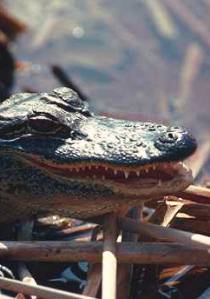9 November 1998
Study Suggests Alligators Once Walked Erect
 A new Ohio University study of how alligators walk is putting a curious twist on the theory that animals with erect postures, such as birds and mammals, evolved from crawling on their bellies to walking erect. The new work suggests alligators evolved in the opposite direction on the evolutionary chart, moving from an upright walk to the semi-erect type of locomotion scientists see today.
A new Ohio University study of how alligators walk is putting a curious twist on the theory that animals with erect postures, such as birds and mammals, evolved from crawling on their bellies to walking erect. The new work suggests alligators evolved in the opposite direction on the evolutionary chart, moving from an upright walk to the semi-erect type of locomotion scientists see today.
"The path of evolution usually goes from sprawling to erect. What we're suggesting is unusual because it seems that alligators went from erect to semi-erect," said Stephen Reilly, associate professor of biological sciences and lead author of this new study.
For their studies, published in a recent issue of the Journal of Experimental Biology, researchers filmed alligators running on a 2 foot treadmill to examine movement of the reptiles' joints and limbs as they walked. They compared different locomotive patterns in the alligators: the sprawling posture in which the alligators drag their bellies on the ground and the semi-erect posture, also called a "highwalk," in which the alligators hold themselves off the ground while walking.
Earlier research suggested that the alligators' "sprawl" was similar to the primitive sprawling locomotion of salamanders and lizards. But when Reilly and co-author Jason A. Elias, an undergraduate in biological sciences at Ohio University, examined video footage of the gator sprawls, they found it to be a semi-erect posture that was more similar to the gators' highwalk.
Reilly has studied locomotion of lizards - definite sprawlers - and birds, which clearly walk erect. When he compared the limb and joint movements of the alligators to these animals, he found that the alligators didn't fit neatly into either the sprawling or erect categories as other researchers have suggested.
In addition, when the alligators increased their speed, researchers noted that they did so by changing ankle movements rather than hip movements as seen in other four-footed vertebrates.
"Alligators walk differently than other vertebrates," Reilly said. "What's more, they have evolved back toward a more sprawling posture from erect ancestors."
For scientists who use alligators as a model to study the evolution of animal locomotion from sprawling to erect, Reilly's research indicates they may need to find a new model. "Our work suggests that alligators are problematic as an intermediate model for the evolutionary transition from sprawling to erect postures," he said.
